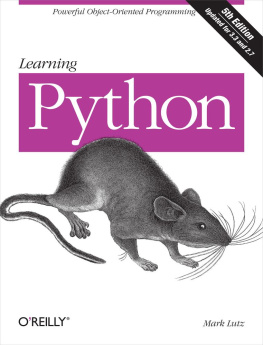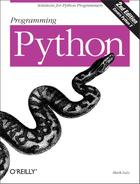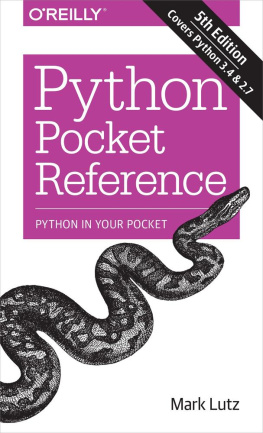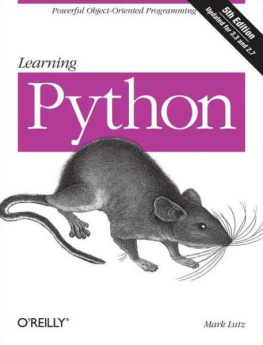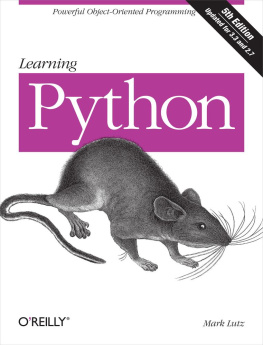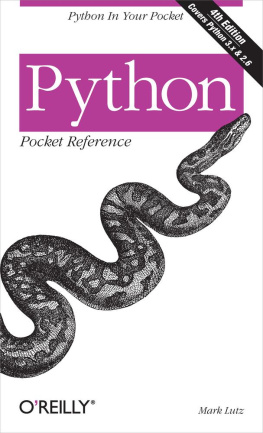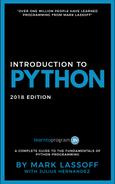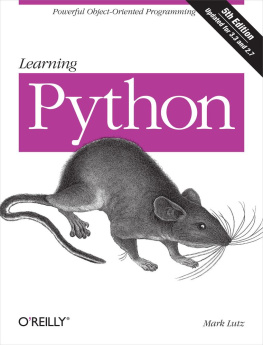Mark Lutz - Learning Python, Fourth Edition
Here you can read online Mark Lutz - Learning Python, Fourth Edition full text of the book (entire story) in english for free. Download pdf and epub, get meaning, cover and reviews about this ebook. City: [S.l.], publisher: OReilly Media Inc, genre: Computer. Description of the work, (preface) as well as reviews are available. Best literature library LitArk.com created for fans of good reading and offers a wide selection of genres:
Romance novel
Science fiction
Adventure
Detective
Science
History
Home and family
Prose
Art
Politics
Computer
Non-fiction
Religion
Business
Children
Humor
Choose a favorite category and find really read worthwhile books. Enjoy immersion in the world of imagination, feel the emotions of the characters or learn something new for yourself, make an fascinating discovery.

Learning Python, Fourth Edition: summary, description and annotation
We offer to read an annotation, description, summary or preface (depends on what the author of the book "Learning Python, Fourth Edition" wrote himself). If you haven't found the necessary information about the book — write in the comments, we will try to find it.
Learning Python, Fourth Edition — read online for free the complete book (whole text) full work
Below is the text of the book, divided by pages. System saving the place of the last page read, allows you to conveniently read the book "Learning Python, Fourth Edition" online for free, without having to search again every time where you left off. Put a bookmark, and you can go to the page where you finished reading at any time.
Font size:
Interval:
Bookmark:
Copyright 2009 Mark Lutz
OReilly books may be purchased for educational, business, or sales promotional use. Online editions are also available for most titles (.
Nutshell Handbook, the Nutshell Handbook logo, and the OReilly logo are registered trademarks of OReilly Media, Inc. Learning Python , the image of a wood rat, and related trade dress are trademarks of OReilly Media, Inc.
Many of the designations used by manufacturers and sellers to distinguish their products are claimed as trademarks. Where those designations appear in this book, and OReilly Media, Inc., was aware of a trademark claim, the designations have been printed in caps or initial caps.
While every precaution has been taken in the preparation of this book, the publisher and author assume no responsibility for errors or omissions, or for damages resulting from the use of the information contained herein.

To Vera.
You are my life.
This book provides an introduction to the Python programming language. Python is a popular open source programming language used for both standalone programs and scripting applications in a wide variety of domains. It is free, portable, powerful, and remarkably easy and fun to use. Programmers from every corner of the software industry have found Pythons focus on developer productivity and software quality to be a strategic advantage in projects both large and small.
Whether you are new to programming or are a professional developer, this books goal is to bring you quickly up to speed on the fundamentals of the core Python language. After reading this book, you will know enough about Python to apply it in whatever application domains you choose to explore.
By design, this book is a tutorial that focuses on the core Python language itself, rather than specific applications of it. As such, its intended to serve as the first in a two-volume set:
Learning Python , this book, teaches Python itself.
Programming Python, among others, shows what you can do with Python after youve learned it.
That is, applications-focused books such as Programming Python pick up where this book leaves off, exploring Pythons role in common domains such as the Web, graphical user interfaces (GUIs), and databases. In addition, the book Python Pocket Reference provides additional reference materials not included here, and it is designed to supplement this book.
Because of this books foundations focus, though, it is able to present Python fundamentals with more depth than many programmers see when first learning the language. And because its based upon a three-day Python training class with quizzes and exercises throughout, this book serves as a self-paced introduction to the language.
This fourth edition of this book has changed in three ways. This edition:
Covers both Python 3.0 and Python 2.6it emphasizes 3.0, but notes differences in 2.6
Includes a set of new chapters mainly targeted at advanced core-language topics
Reorganizes some existing material and expands it with new examples for clarity
As I write this edition in 2009, Python comes in two flavorsversion 3.0 is an emerging and incompatible mutation of the language, and 2.6 retains backward compatibility with the vast body of existing Python code. Although Python 3 is viewed as the future of Python, Python 2 is still widely used and will be supported in parallel with Python 3 for years to come. While 3.0 is largely the same language, it runs almost no code written for prior releases (the mutation of print from statement to function alone, aesthetically sound as it may be, breaks nearly every Python program ever written).
This split presents a bit of a dilemma for both programmers and book authors. While it would be easier for a book to pretend that Python 2 never existed and cover 3 only, this would not address the needs of the large Python user base that exists today. A vast amount of existing code was written for Python 2, and it wont be going away any time soon. And while newcomers to the language can focus on Python 3, anyone who must use code written in the past needs to keep one foot in the Python 2 world today. Since it may be years before all third-party libraries and extensions are ported to Python 3, this fork might not be entirely temporary.
To address this dichotomy and to meet the needs of all potential readers, this edition of this book has been updated to cover both Python 3.0 and Python 2.6 (and later releases in the 3.X and 2.X lines). Its intended for programmers using Python 2, programmers using Python 3, and programmers stuck somewhere between the two.
That is, you can use this book to learn either Python line. Although the focus here is on 3.0 primarily, 2.6 differences and tools are also noted along the way for programmers using older code. While the two versions are largely the same, they diverge in some important ways, and Ill point these out along the way.
For instance, Ill use 3.0 print calls in most examples, but will describe the 2.6 print statement, too, so you can make sense of earlier code. Ill also freely introduce new features, such as the nonlocal statement in 3.0 and the string format method in 2.6 and 3.0, and will point out when such extensions are not present in older Pythons.
If you are learning Python for the first time and dont need to use any legacy code, I encourage you to begin with Python 3.0; it cleans up some longstanding warts in the language, while retaining all the original core ideas and adding some nice new tools. Many popular Python libraries and tools will likely be available for Python 3.0 by the time you read these words, especially given the file I/O performance improvements expected in the upcoming 3.1 release. If you are using a system based on Python 2.X, however, youll find that this book addresses your concerns, too, and will help you migrate to 3.0 in the future.
By proxy, this edition addresses other Python version 2 and 3 releases as well, though some older version 2.X code may not be able to run all the examples here. Although class decorators are available in both Python 2.6 and 3.0, for example, you cannot use them in an older Python 2.X that did not yet have this feature. See Tables later in this Preface for summaries of 2.6 and 3.0 changes.
Shortly before going to press, this book was also augmented with notes about prominent extensions in the upcoming Python 3.1 releasecomma separators and automatic field numbering in string format method calls, multiple context manager syntax in with statements, new methods for numbers, and so on. Because Python 3.1 was targeted primarily at optimization, this book applies directly to this new release as well. In fact, because Python 3.1 supersedes 3.0, and because the latest Python is usually the best Python to fetch and use anyhow, in this book the term Python 3.0 generally refers to the language variations introduced by Python 3.0 but that are present in the entire 3.X line.
Although the main purpose of this edition is to update the examples and material from the preceding edition for 3.0 and 2.6, Ive also added five new chapters to address new topics and add context:
Font size:
Interval:
Bookmark:
Similar books «Learning Python, Fourth Edition»
Look at similar books to Learning Python, Fourth Edition. We have selected literature similar in name and meaning in the hope of providing readers with more options to find new, interesting, not yet read works.
Discussion, reviews of the book Learning Python, Fourth Edition and just readers' own opinions. Leave your comments, write what you think about the work, its meaning or the main characters. Specify what exactly you liked and what you didn't like, and why you think so.

